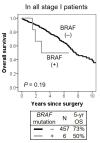KRAS Mutation Is a Significant Prognostic Factor in Early-stage Lung Adenocarcinoma
- PMID: 27740967
- PMCID: PMC5106330
- DOI: 10.1097/PAS.0000000000000744
KRAS Mutation Is a Significant Prognostic Factor in Early-stage Lung Adenocarcinoma
Abstract
The potential clinical impact of KRAS and epidermal growth factor receptor (EGFR) mutations has been investigated in lung adenocarcinomas; however, their prognostic value remains controversial. In our study, we sought to investigate the prognostic significance of driver mutations using a large cohort of early-stage lung adenocarcinomas. We reviewed patients with pathologic early-stage, lymph node-negative, solitary lung adenocarcinoma who had undergone surgical resection (1995 to 2005; stage I/II=463/19). Tumors were classified according to the IASLC/ATS/ERS classification and genotyped by Sequenom MassARRAY system and polymerase chain reaction-based assays. In stage I disease, the Kaplan-Meier method and cumulative incidence of recurrence analyses were used to estimate the probability of overall survival (OS) and recurrence, respectively. Of all, 129 (27%) patients had mutations in KRAS, 86 (18%) in EGFR, 8 (2%) in BRAF, 8 (2%) in PIK3CA, 4 (1%) in NRAS, and 1 (0.2%) in AKT1. EGFR L858R mutation correlated with lepidic predominant histology (P=0.006), whereas exon 19 deletion correlated with acinar predominant histology (P<0.001). EGFR mutations were not detected in invasive mucinous adenocarcinomas (P=0.033). The 5-year OS of patients with KRAS-mutant tumors was significantly worse (n=124; 5-year OS, 63%) than those with KRAS wild-type (n=339; 77%; P<0.001). In solid predominant tumors, KRAS mutations correlated with worse OS (P=0.008) and increased risk of recurrence (P=0.005). On multivariate analysis, KRAS mutation was an independent prognosticator of OS in all patients (hazard ratio, 1.87; P<0.001) and recurrence in solid predominant tumors (hazard ratio, 4.73; P=0.012). In patients with resected stage I lung adenocarcinomas, KRAS mutation was an independent prognostic factor for OS and recurrence, especially in solid predominant tumors.
Conflict of interest statement
DISCLOSURES The authors made no disclosures.
Figures




References
-
- Lynch TJ, Bell DW, Sordella R, et al. Activating mutations in the epidermal growth factor receptor underlying responsiveness of non-small-cell lung cancer to gefitinib. N Engl J Med. 2004;350:2129–2139. - PubMed
-
- Paez JG, Janne PA, Lee JC, et al. EGFR mutations in lung cancer: Correlation with clinical response to gefitinib therapy. Science. 2004;304:1497–1500. - PubMed
-
- Shigematsu H, Lin L, Takahashi T, et al. Clinical and biological features associated with epidermal growth factor receptor gene mutations in lung cancers. J Natl Cancer Inst. 2005;97:339–346. - PubMed
-
- Tam IY, Chung LP, Suen WS, et al. Distinct epidermal growth factor receptor and KRAS mutation patterns in non-small cell lung cancer patients with different tobacco exposure and clinicopathologic features. Clin Cancer Res. 2006;12:1647–1653. - PubMed
MeSH terms
Substances
Grants and funding
LinkOut - more resources
Full Text Sources
Other Literature Sources
Medical
Research Materials
Miscellaneous

